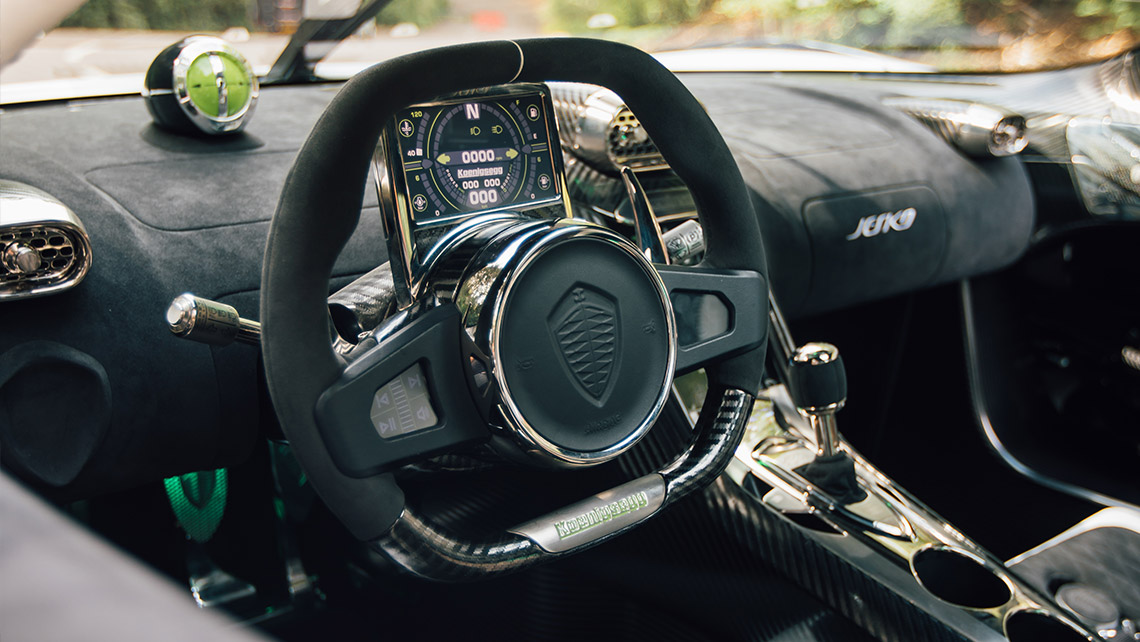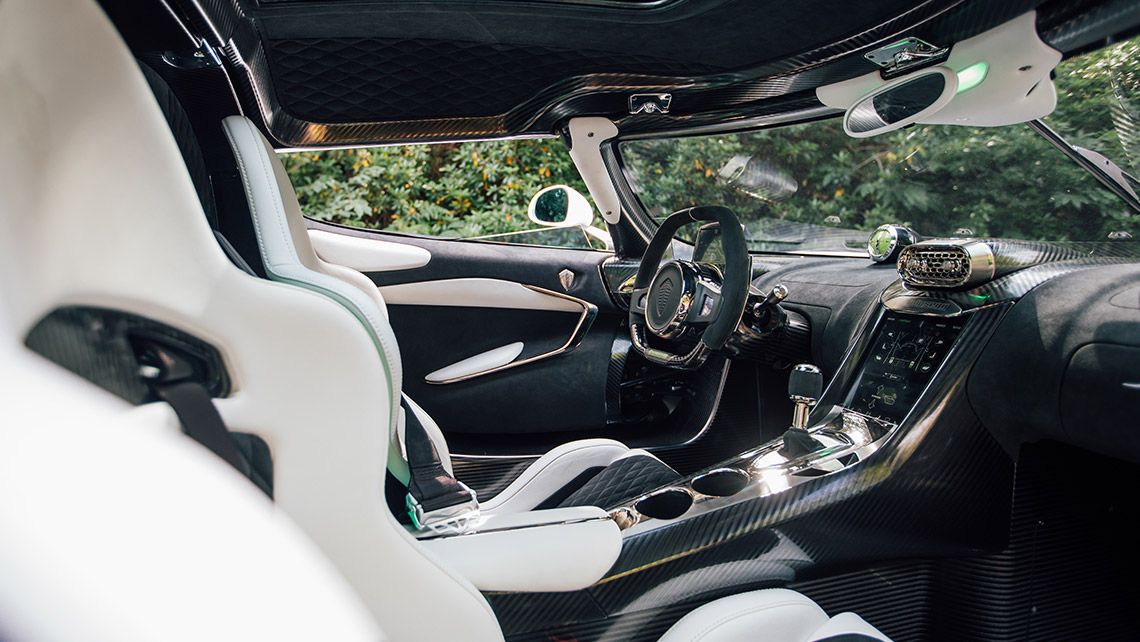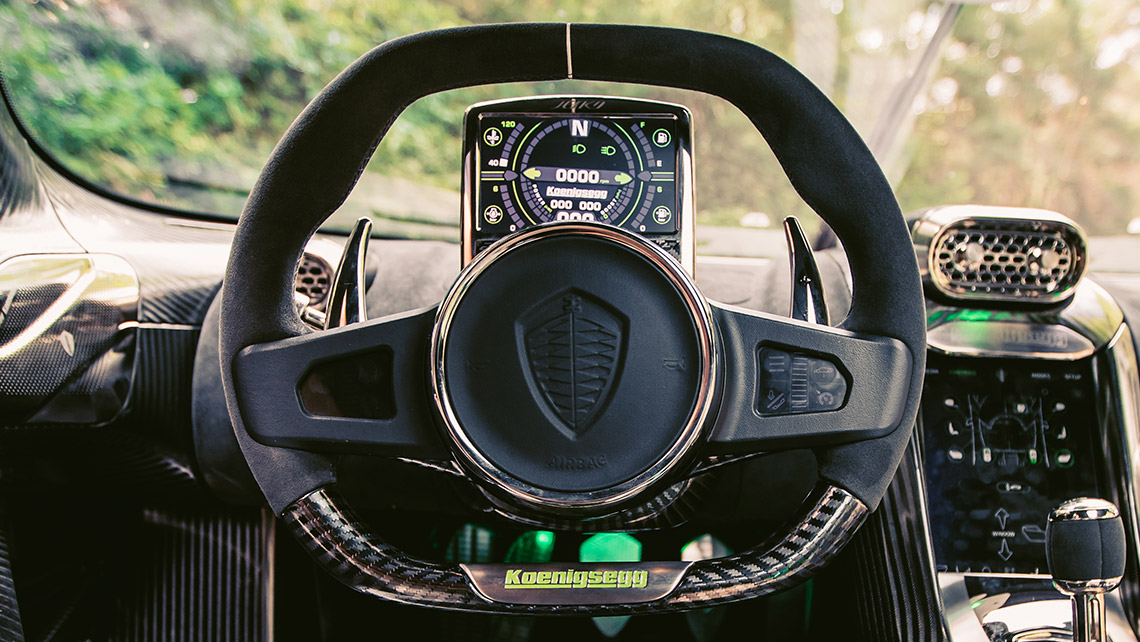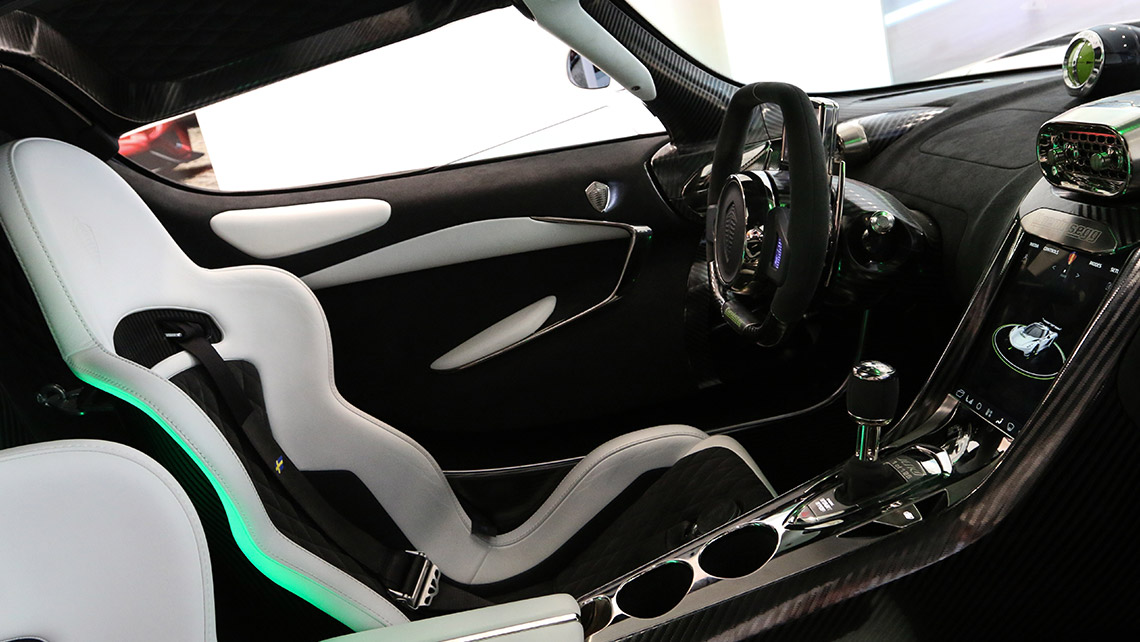Koenigsegg Jesko, high performance track car

Koenigsegg has unveiled an all-new megacar – the Koenigsegg Jesko – at the 2019 Geneva International Motor Show. Jesko inherits the mantle left by the Agera RS as the leading track-focused, road-legal car for those looking for the ultimate in vehicle performance.
- Re-designed 5.0 litre twin-turbo V8 engine producing 1280hp on standard gasoline and 1600hp on E85 biofuel
- Revolutionary new 9-speed Koenigsegg Light Speed Transmission (LST)
- Advanced aerodynamics offering over 1000kg of downforce
- Active rear-wheel steering
- Re-designed carbon fibre chassis with more legroom, headroom and greater visibility
Jesko is named for Jesko von Koenigsegg, the father of company Founder and CEO, Christian von Koenigsegg.
Jesko von Koenigsegg was a key presence at Koenigsegg Automotive during its formative years. His considerable business acumen helped steer the company through many early challenges. Now retired and in his 80’s, Jesko von Koenigsegg and his wife, Brita, were on-hand at the 2019 Geneva Motor Show to see his namesake vehicle introduced to the world.
A New Heart
Koenigsegg’s first effort at engine development was so successful it saw the company awarded a Guinness World Record. The Koenigsegg CC8S replaced the McLaren F1 as the car with the most powerful production engine in the world.
The next Koenigsegg engine achieved a similar feat when the CCR took the world production car top speed record, again from the McLaren F1. In 2014, we announced the Koenigsegg One:1 with a twin-turbo V8 producing 1,360 hp, enough to make the One:1 the first production car in history with a 1:1 power-to-weight ratio. With 1 megawatt of power, the One:1 was the world’s first Megacar.
That record-breaking tradition continues……
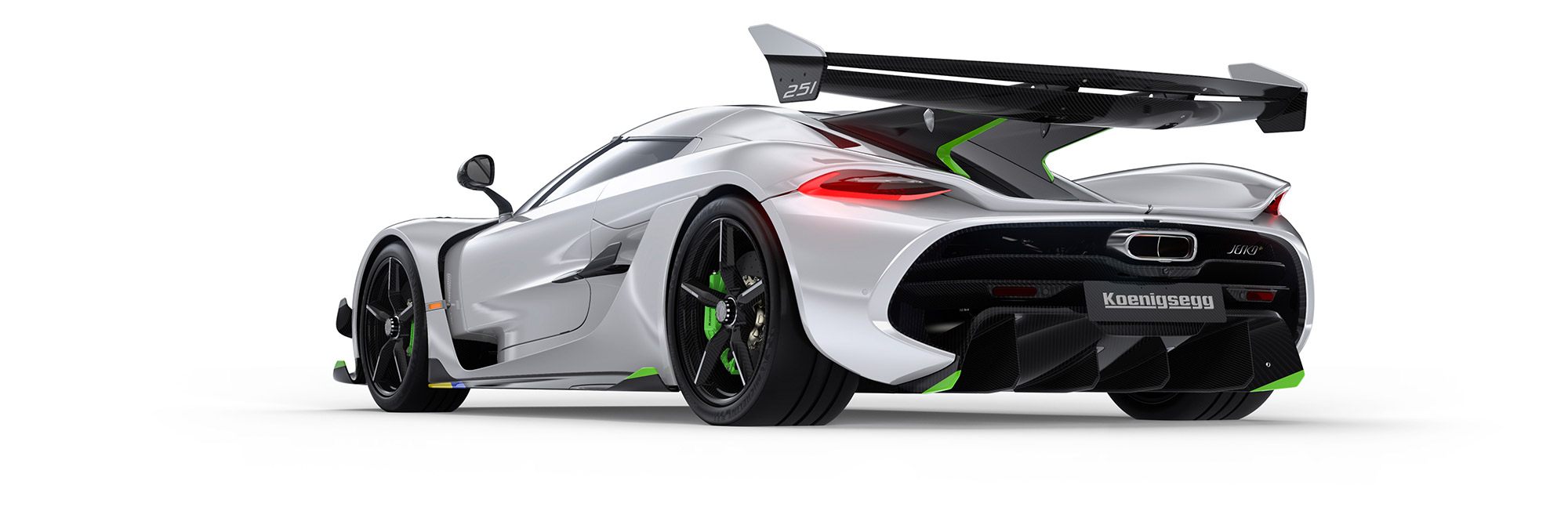
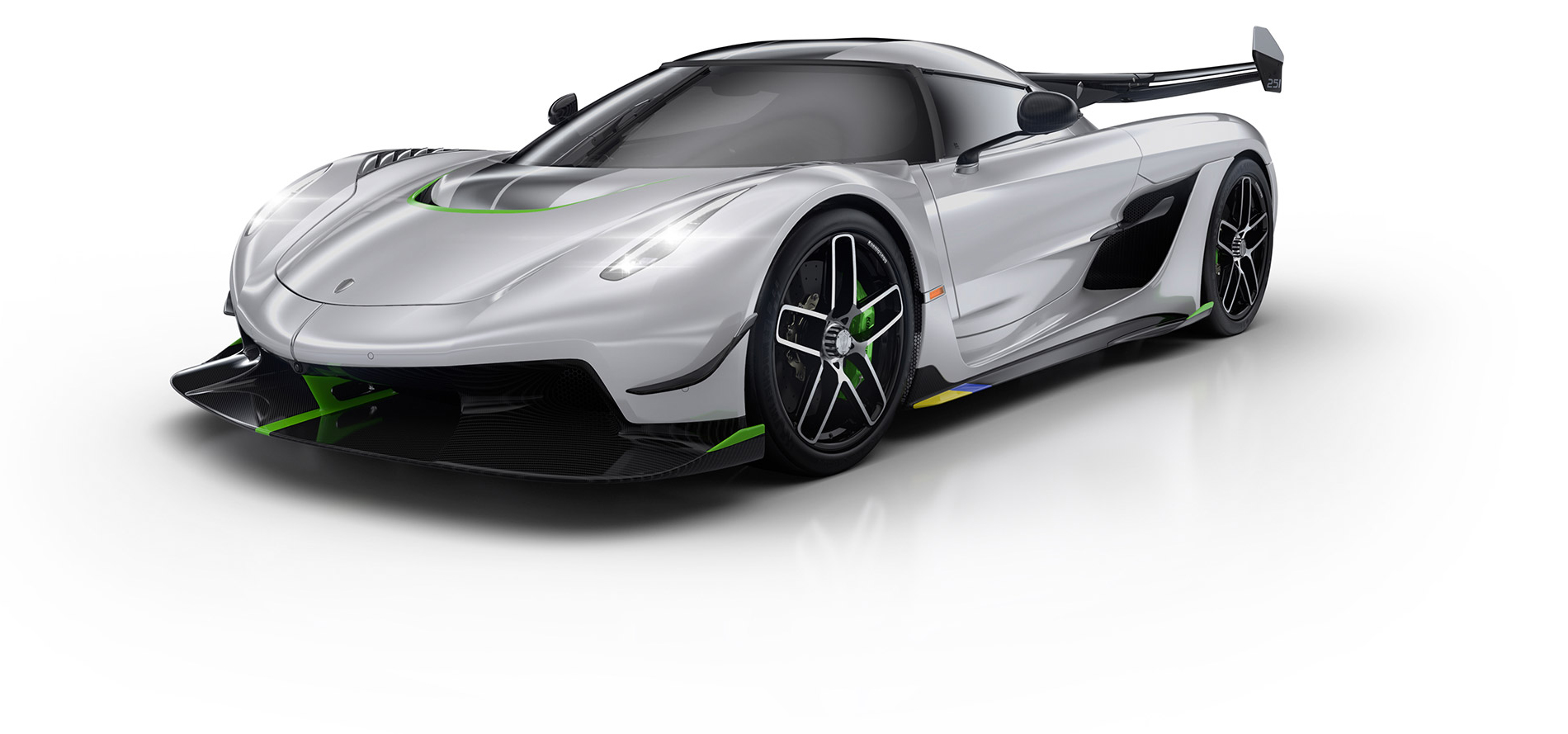
Jesko – the all-new megacar from Koenigsegg – is powered by a newly designed, 1280hp (1600hp on E85), twin-turbocharged V8 engine that benefits from significant changes to the Agera engine it replaces.
At the core of the newly designed engine is the world’s lightest V8 crankshaft. Weighing just 12.5 kilos, Koenigsegg’s new flat-plane 180-degree crankshaft allows Jesko to produce more power, with greater efficiency, while achieving a higher 8500rpm rev limit.
The crankshaft is milled by small manufacturing house located in southern Sweden. It is made to Koenigsegg’s in-house design from a single solid steel billet.
The flat-plane design allows even firing across engine banks and an even more visceral engine sound. Koenigsegg has countered the tendency that flat-plane engines have towards greater vibration by designing new super-light connecting rods and pistons.
The connecting rods were designed by Koenigsegg’s engine architect, Dr. Thomas Johansson. The connecting rods are made from premium Swedish steel. At just 540g – including bolts – they’re as light as previous generations made from titanium, but even stronger.
The piston’s curved face shapes the combustion chamber in such a way so as to reduce peak pressure while maintaining high average pressure. The ceramic coating on the face of the piston prevents hot spots and detonation when the engine runs at maximum power. The piston weighs just 290 grams. Minimal weight is important because Koenigsegg engines have a very long stroke and at 8500rpm, efficiency of movement becomes critical.
- Read More about Jesko's Engine
-
The engine head has been redesigned with a ‘tumble’ valve on the intake side to increase turbulence as air is pumped into the engine. Turbulent air provides a faster burn rate, which leads to more efficient and effective combustion. The head is cast by Formula 1 suppliers Grainger and Worrall using new F1-grade technology to produce a head that is both stronger and lighter.
The air injection system comprises a small electric compressor driving air from a 20-litre carbon fibre tank connected directly to the two large turbochargers.
Traditional turbochargers are often burdened with turbo lag – the gap where exhaust driven gases are insufficient to transfer boost via the compressor wheel to the intake side. Bigger turbos mean even more lag, which is why many companies opt for twin-turbo systems with a small, fast-spooling turbo providing quick response before a larger turbo engages to provide maximum boost.
The Koenigsegg air injection system uses a timed, 20-bar burst of air strategically aimed within the patent-pending turbo housing in order to pre-spool the two large turbos. This process eliminates turbo lag and surge. This unique solution provides instant response with massive boost prior to the exhaust gases taking over to power the turbos.
The air injection system is also used to accelerate the process by which Jesko’s catalytic converters get to operating temperature on start-up. This is an important emissions reduction measure and fits with the Koenigsegg efficiency philosophy – using systems or parts to perform more than one function.
The fuel injection system has been re-designed and now includes an extra fuel injector, making Jesko the first production car in the world with three injectors per cylinder. Koenigsegg’s V8 has always had two injectors per cylinder fitted to the traditional fuel rail. A third injector has been added in the intake plenum, which injects fuel directly above the intake trumpets for each cylinder. The added aeration means a much cooler cylinder, much cleaner combustion, and less strain on the engine at the top of the power range.
The cylinders in Jesko’s new twin-turbo V8 are fitted with the world’s first individual in-cylinder pressure sensor system for serial production. This allows the Koenigsegg-designed and manufactured Engine Management System to monitor and operate each cylinder at maximum efficiency and closer to the edge for the ultimate in flexibility and control.
This mix of wholesale changes and incremental technology improvements results in an increase in the engine’s rev limit – to 8500rpm – and an increase in power to 1600hp on E85 fuel. When run on regular gasoline, the engine produces 1280hp. Torque is increased to 1500 Nm.
Jesko features not only the most powerful Koenigsegg internal combustion engine ever made, but also – we believe – the most powerful internal combustion engine of any homologated production car in history.
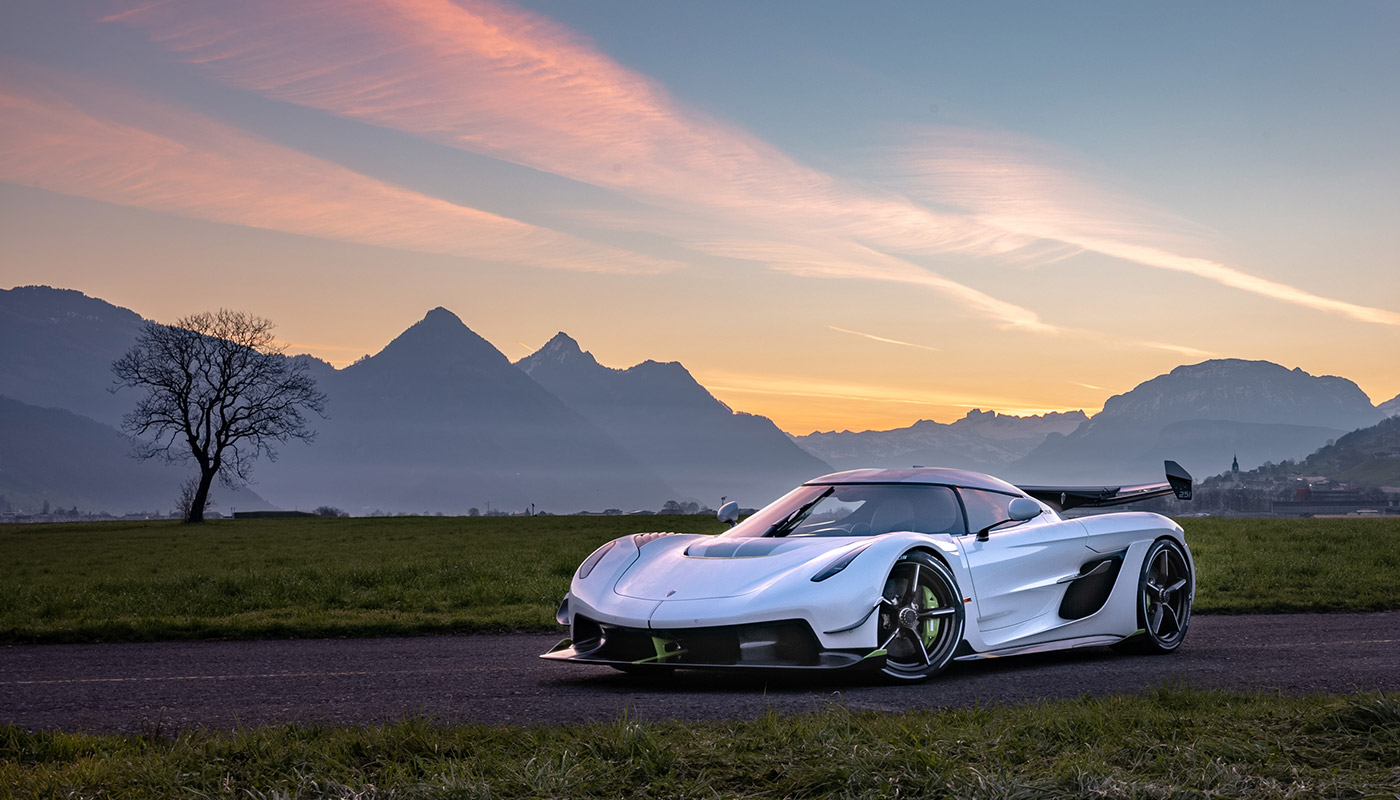
Light Speed Transmission (LST)
The Koenigsegg Jesko features an all-new 9-speed, multi-clutch transmission – the second transmission to be 100% designed and built in-house at Koenigsegg, following the Direct Drive system designed for the Regera.
The Koenigsegg Light Speed Transmission (LST) represents a scale of evolution not seen since the development of modern dual-clutch technology at the turn of the century.
LST comprises nine forward gears and several wet, multidisc clutches in a compact, ultra-light package. The LST is capable of upward and downward gear changes between gears at near light speed thanks to the simultaneous opening and closing of clutches that allows for totally seamless acceleration/deceleration.
That LST gear changes can occur in virtually zero time between adjacent gears is impressive.
What takes LST from impressive to evolutionary, however, is that these shift-time benefits apply when changing between ANY forward gears.
- Read More about LST
-
DUAL-MODE SHIFT
The Koenigsegg LST uses shifting mechanisms with two modes to differentiate between ‘normal’ (single-increment) and UPOD gear changes. The gear selector paddles and central shifter both have notched mechanisms that allow for two types of shifting.
Press the desired paddle or central shifter to the first notch and the transmission instantly changes one gear, as normal.
Press the paddle or the central shifter beyond that first notch and you are actively making use of UPOD’s jump capability. The transmission’s intelligent UPOD system will instantly detect your optimum gear and engage that gear for you.
FLEXIBLE SHIFT
Many drivers miss the organic feeling of a manual shifter and how it makes you feel more engaged with the car. Jesko offers its unique LST shifting capability in two different forms – paddle shift and ‘manual’ shift.
Modern sports car drivers are already accustomed to steering wheel paddles. They will feel perfectly accustomed to shifting gear in Jesko with dual-notch paddles located in the customary position, behind the steering wheel.
Jesko also offers an old-school alternative, with a short-throw ‘stick-shift’ installed and fitted with the same dual-notch operation. A push to the first notch changes one gear. A harder push to the second notch initiates UPOD and maximises the Koenigsegg LST´s full capabilities.
LIGHT | SPEED
The Koenigsegg LST represents a revolution in the way multi-clutch transmissions drive your vehicle.
Equally revolutionary is the size and weight of the system.
Where ‘traditional’ dual-clutch technology improved vehicle performance, this improvement came at a significant cost in terms of weight. Modern high-performance DCTs can easily weigh well in excess of 120 kilograms, and DCT-equipped cars always weigh more than their manual-transmission counterparts.
Minimisation of weight lies at the heart of the Koenigsegg philosophy and the Koenigsegg LST is no exception.
It provides vastly improved performance and functionality, yet the 9-speed Koenigsegg LST transmission weighs just 90kg, including all fluids. The physical package is less than 50% of the length of Koenigsegg’s previous-generation 7-speed CIMA transmission. This small size keeps weight closer to the center of the car, improving weight distribution and handling.
Koenigsegg’s new Light Speed Transmission, coupled with Jesko’s increased engine output and improved aerodynamics deliver the ultimate road-friendly track car. It continues Koenigsegg’s tradition of innovation and advances the company’s ongoing quest – the pursuit of automotive perfection.
UPOD – ULTIMATE POWER ON DEMAND
The key to this functionality is found in both the transmission’s unique design and Koenigsegg’s intelligent ‘UPOD’ technology – Ultimate Power On Demand. UPOD is the brain that instantly selects and engages optimum gearing for maximum acceleration.
While modern dual-clutch transmissions (DCT) enjoy millisecond shift times, they can only pre-select for a fast shift in one direction. DCT’s are designed to predict and pre-select the next gear based on inputs from the driver. If that prediction is wrong – e.g the driver wants to shift from 5th gear to 4th, instead of the presumed and pre-selected 6th gear – the driver will experience G-force losses and a slow shift response.
In addition, DCT’s only work in single-gear intervals. From 7th gear to 6th, to 5th, to 4th, for example. If the driver is in 7th gear and wants 4th for maximum power, the DCT cannot pre-select 4th gear directly. The driver has to pass through 6th and 5th gears, wasting time and power.
The Koenigsegg LST overcomes this via its unique multi-clutch design and UPOD technology, which selects the optimum gear for maximum power with a light speed gear change, regardless of whether that gear is 1, 2 or even 5 gears away.
UPOD uses vehicle speed and engine speed to determine the correct gear for maximum power and directs the LST to engage that gear, no matter its relationship to the current gear. If you are in 7th gear and 4th is the optimal gear for maximum acceleration, UPOD can bypass downshifts to 6th and 5th gear and put the car directly from 7th to 4th – in light speed.
The effect is instant, prolific power that’s always optimised and always available, allowing maximum acceleration for overtaking, corner exits, etc.
Koenigsegg has a long history of developing innovative, in-house solutions aimed at optimising vehicle performance. Near-enough is never good-enough. This no-compromise philosophy inspired the development of Aircore carbon fibre wheels, Koenigsegg Direct Drive, Triplex suspension geometry, the RocketCat catalytic converter, Autoskin technology, and much more. LST is the latest in a long line of Koenigsegg innovations.
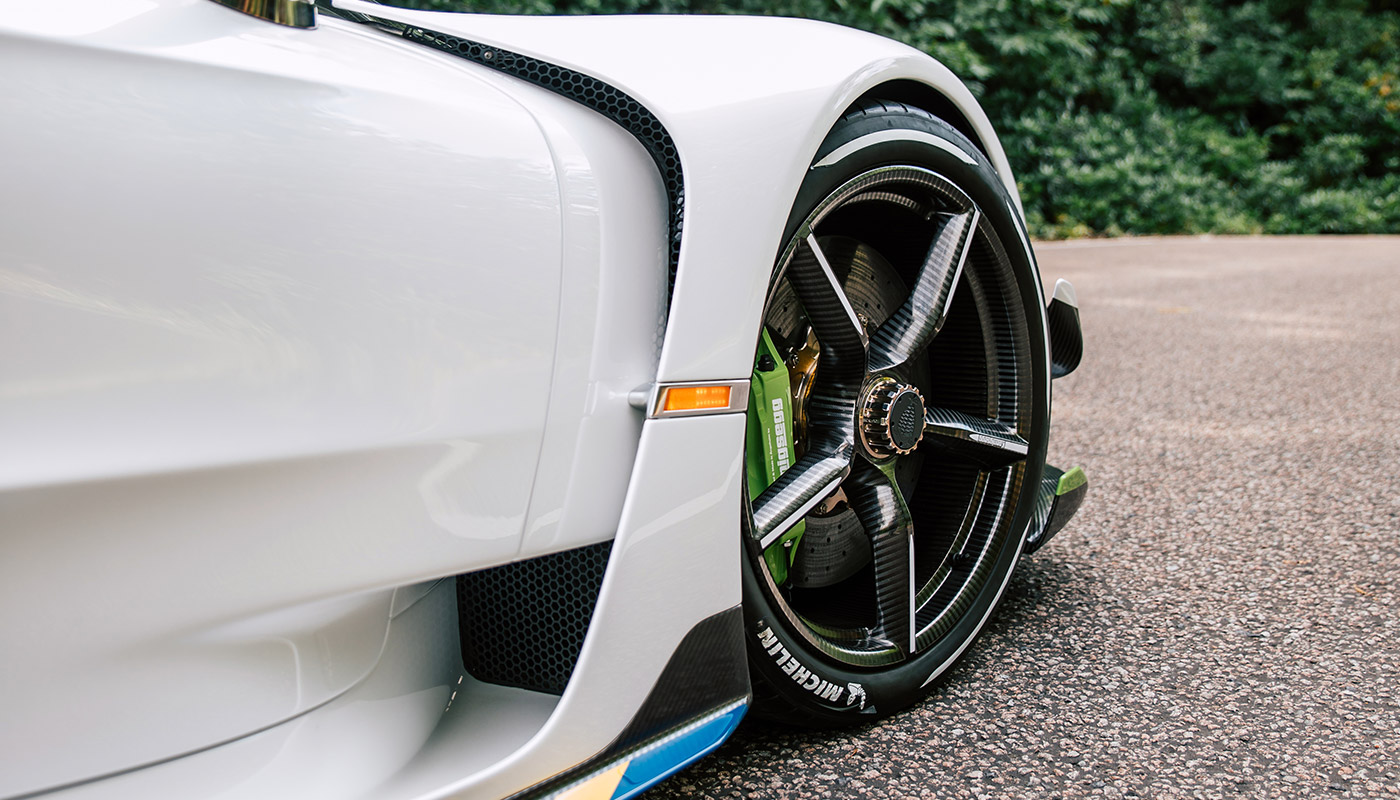
Suspension and Steering
The Koenigsegg Jesko was designed as the ultimate road-friendly track car.
As such, we’ve re-engineered what was already a class-leading chassis, equipping it with a host of new technologies to make driving easier around town and much faster on the circuit.
A STRONG CORE
At the core of every Koenigsegg is its carbon fibre monocoque.
Jesko uses an all-new monocoque, designed with the experience of vehicles past but with the requirements of our future customers in mind. The new tub is 40mm longer and 22mm higher, which allows for more legroom, headroom, a more spacious cabin feel and a clearer view through the wrap-around windscreen.
The tub retains its industry-best torsional rigidity, at 65,000 Nm per degree. The Koenigsegg chassis has long proven to be an outstanding base for chassis tuning. It’s also extremely strong and safe, with both the Agera RS and Regera passing crash tests for both EU and USA homologation in recent years.
The monocoque is a carbon fibre and aluminium sandwich construction with integrated fuel tanks, rollover bars and reinforcement using Dyneema – the strongest fibre in the world – an industry first. It is assembled in our factory in Ängelholm, Sweden.
TRIPLEXTENDED
Koenigsegg has equipped Jesko with an adaptive, active rear steering system that increases responsiveness and heightens the senses at both high and low speeds.
Using inputs such as speed, throttle and brake positions, steering and slip angles and other parameters, the steering system can turn the rear wheels up to three degrees in either direction for quicker cornering and increased stability.
At low speeds, the system counter-steers the rear wheels. This gives Jesko a faster turn-in, effectively shortening the turning circle of the car.
At high speeds, the rear wheels turn with the front wheels, a virtual lengthening of the wheelbase. This improves cornering performance on the track and provides increased stability on the road.
The result:
Faster cornering, better maneuverability, improved steering feel, more grip and increased confidence.
ACTIVE REAR STEERING
Koenigsegg has equipped Jesko with an adaptive, active rear steering system that increases responsiveness and heightens the senses at both high and low speeds.
Using inputs such as speed, throttle and brake positions, steering and slip angles and other parameters, the steering system can turn the rear wheels up to three degrees in either direction for quicker cornering and increased stability.
At low speeds, the system counter-steers the rear wheels. This gives Jesko a faster turn-in, effectively shortening the turning circle of the car.
At high speeds, the rear wheels turn with the front wheels, a virtual lengthening of the wheelbase. This improves cornering performance on the track and provides increased stability on the road.
The result:
Faster cornering, better maneuverability, improved steering feel, more grip and increased confidence.
- Read More about Suspension and Steering
-
ACTIVE ENGINE MOUNTS
The engine mounts used in the new Koenigsegg Jesko are taken from the existing Regera. They are active engine mounts designed to deliver a more relaxed ride at lower speed.
When driving at posted speeds, the mounts stay soft to isolate engine noise and vibrations. During spirited driving, the mounts firm up to solidify the car and give greater response. The effect is visceral, transforming the car from relaxed to active in the blink of an eye.
NEW WHEEL DESIGNS
Jesko is equipped with two new wheel designs – one forged aluminium and one carbon fibre. Both are designed to be as light as possible for their size, with the carbon wheels being the super-light option.
Both front and rear wheels are larger than the Agera wheels that came before them. Still, the 21” x 12” rear carbon wheels weigh just 8.4 kilograms each, while the 20” x 9.5” front wheels weigh 6.7 kilograms.
Lighter wheels help to minimise unsprung weight – the mass that is not controlled by the vehicle’s suspension system. They also allow for faster acceleration, better braking and more responsive cornering.
The enlarged wheel design allows for larger brake discs and better brake cooling while still retaining optimal strength and super-light weight for the wheel’s size.
CLASS-LEADING GRIP
Jesko’s new wheels are fitted with Michelin Pilot Sport Cup 2 tires as standard. Michelin’s all-new Pilot Sport Cup 2 R is an available option for dry weather use only.
The Pilot Sport Cup 2 R is Michelin’s latest high-performance tire. It features a new compound, increased sidewall strength and a new tread pattern to provide a contact patch 10% bigger than the standard Cup 2 tire.
Michelin’s track tests suggest an improvement in lap times with the Cup 2 R similar to what the same car on standard Cup 2’s might achieve with a 10-30% increase in engine output, depending on the car.
Koenigsegg works closely with Michelin to provide customers the absolute best in on-track and on-street performance. The new Michelin Pilot Sport Cup 2 R is the perfect compliment to Jesko’s new engine, gearbox, chassis and aerodynamics package.
Design and Aerodynamics
The all-new Koenigsegg Jesko is the successor to the Agera line in the Koenigsegg portfolio and has inherited not only a place in the lineup, but a rich design heritage, as well.
Joachim Nordwall, Design Director:
Even though the Agera turned out to be a road monster, there was a level of simplicity and humility to its design, something that reflects the character of both Koenigsegg as a company, and our founder, Christian von Koenigsegg. This design ethos is also present in Jesko. It’s both humble and assertive, but not angry.
The shape is instantly familiar and there are a number of design cues that tip their hat in respect to the outgoing Agera. The dip between the rear lamps, for example, which is present, but done in a more modern way. The wraparound windscreen is there, too, but now has more of a fighter jet stance thanks to a taller roof line. The headlamps were given a more dynamic approach, morphing closer to the Regera shape but retaining an identity of their own.
Cues from the Regera do not stop there. Jesko has a similar design at the rear with an open design for increased airflow and an exhaust reminiscent of the inverter heat extraction outlet on the Regera. The air ducts at the front wheel are also similar.
Jesko looks smaller than the Agera and Regera, thanks to it having more shape around the wheels. It’s actually 30mm taller and 40mm longer than the Agera, which allows for better ingress and egress, a more spacious cabin and better visibility.
It also looks more agile. We adopted a ‘shrinkwrap’ approach to skinning this car, using crisp angles and lines to eliminate empty spaces and make the design as effective as possible.
I’m proud of what we’ve achieved with this car. It’s new, but it’s also classic Koenigsegg.
AERODYNAMICS
The Koenigsegg Jesko features aerodynamics designed with one goal in mind – blistering on-track performance.
As Jesko is an all-new vehicle, Koenigsegg went back to the drawing board and designed an all-new rear wing, new front splitter and new rear diffuser. These form the core of an active aerodynamics and airflow package that maximises downforce while minimising drag.
The signature, airplane-like wrap-around windscreen stays intact, albeit improved for visibility. The Koenigsegg wrap-around windscreen has always played a crucial role in the aerodynamic performance of Koenigsegg cars, as no other windscreen solution can offer the same drag efficiency and high-speed stability. It also reduces upper body lift and delivers high quality airflow to the rear wing.
- Read More about AERODYNAMICS
-
The new double-profile rear wing has been placed as far back as possible for maximum downforce and increased control. Following a design first used in the Koenigsegg One:1, the wing is top-mounted to minimise disturbance on the underside of the wing – the surface most responsible for providing downforce.
The wing is boomerang shaped, mirroring the rear curvature of the car as closely as possible in order to maximise the wing’s surface area and ensure the most extreme rearward positioning. The new rear wing is a double-profile design that allows a higher angle of attack without stalling the wing, resulting in higher downforce.
The front splitter is the deepest/longest ever used on a Koenigsegg car and features integrated active flaps underneath to maximise on-track performance. Flap size has been increased to balance the front of the car against the enlarged rear wing. This balance is critical in managing over/understeer. The active front flaps can even assist with preserving the nose of the car, releasing downforce during braking to prevent the front of the car from scraping against the road.
The design process for Jesko has been a constant dance between aesthetics and airflow. Panel surfaces were designed, then flow-tested, re-designed, then flow-tested – again and again. This evolution led us to a design that remains visually stunning while delivering astounding aerodynamic capability.
Airflow efficiency is critical for two reasons. First, to direct air where it’s needed, whether it be for downforce, for engine intake or for cooling. Second, to direct excess air as efficiently as possible to avoid turbulence, which results in drag.
Jesko has been designed with this in mind, using the air to push the car into the tarmac while at the same time, passing through that air in as slippery a manner as possible. The rear wing angle is variable, capable of either maximum downforce or low drag settings, which are controlled automatically depending on driving conditions.
Subtle areas also contribute to this effort. The vented areas over the front tyres, for example, disperse low-pressure air from the tyre well that can cause lift, which would negatively impact steering feel and handling.
Even the rear view mirrors play a part, adding 20kg of downforce and directing airflow towards the rear of the vehicle.
In terms of cooling, air from underneath the front of the car is directed towards the intercooler intakes at the sides. The rear of the car has been left open to allow maximum airflow, thereby evacuating heat from the engine bay.
The result of this focus on balancing maximum downforce with minimal drag is the most aerodynamically aggressive car ever to wear a Koenigsegg badge, as can be seen by the car’s amazing downforce numbers:
Jesko delivers a downforce payload of 800 kilograms at 250 km/h at the car’s most aggressive setting. That figure rises to 1000 kg at 275 km/h before reaching a maximum of 1400kg. These figures are a 30% increase over the Koenigsegg One:1 at similar speeds, and a 40% increase over the Agera RS.
Koenigsegg’s aerodynamics team has harnessed nature to provide unprecedented straight-line and lateral grip.
Working with the design team, they have combined this capability with stunning, flowing lines, thereby fulfilling the brief for a design that is 100% Koenigsegg, and 100% focused on astounding track performance.
Interior and Equipment
The new Koenigsegg Jesko is unapologetically designed to be the most capable track-oriented car ever made for the road. It is engineered for prodigious speed – both straight-line and lateral – with total driver control.
That doesn’t mean one has to be uncomfortable, however.
Jesko is equipped with a full suite of creature comforts and a level of convenience more befitting a grand tourer than your typical track weapon.
The simple push of a button on the elegant Koenigsegg remote control operates Autoskin, the pioneering body opening system first shown on the Regera. Minituarised hydraulics that were initially designed to operate aerodynamic systems now engage to open the car’s doors and hoods, allowing true touchless entry.
Koenigsegg’s signature dihedral synchro-helix door hinge has also been re-designed. It now opens slightly outwards and upwards compared to the original. This provides even more room for ingress and egress, and reduces the danger of scraping high curbs. The Autoskin system includes sensors to protect both automated doors from opening where an obstruction is detected.
The interior is swathed in luxury materials – leather, alcantara, carbon fibre, aluminium and glass.
Jesko’s electrically operated seats can be finished in the customer’s choice of leather or alcantara, with an almost endless variety of colour and contrast options. The sport bucket seats are built around a carbon fibre seat shell, resulting in a seat that is both extremely light and comfortable. Controls for seat position and heating are available via the SmartCenter touchscreen. Drivers can find the perfect driving position by matching their seat position with the fully adjustable steering column and pedal box.
SMARTWHEEL ADDED TO KOENIGSEGG’S SMART ARCHITECTURE
Koenigsegg has developed new driver controls using touchscreen technology built into both the new SmartCenter and SmartWheel.
SmartWheel sees two small touchscreens embedded into Jesko’s steering wheel, making a suite of features accessible with just a touch or a swipe. The screens’ default configurations enable functions such as audio control, phone control, ride height control and cruise control. The screens are context sensitive, however, and other options may show or be configured into the system. SmartWheel’s screens feature haptic feedback, allowing ease of use without the need for constant visual connection.
Jesko features a new, racing-inspired and very compact SmartCluster instrument screen. The screen is mounted directly behind the steering wheel and turns as the steering wheel turns. The new 5-inch SmartCluster is extremely compact – it measures just 108mm x 64.8mm – but it contains all the information the driver needs in a neat, logical layout.
- Read More about Equipment
-
The SmartCluster has a circular central zone full of essential information – tachometer, speedometer, power, boost, gear selection and essential driver warning lamps. Outside of the central zone are gauges for fuel level, fuel pressure, oil pressure and temperature.
While the Smartcluster screen physically rotates with the steering wheel, the central zone – and the key information within it – always remains level. This ensures the information is always readable. Having the screen rotate with the steering wheel means it is never obscured by the steering wheel spokes as the wheel is turned.
The 9-inch SmartCenter touchscreen provides control over various infotainment and control systems installed in the car.
Driver and passenger can use SmartCenter to operate the automated climate control system, audio and navigations systems, Bluetooth connectivity controls (inductive charging is fitted), custom lighting controls, and electric controls for mirrors, doors, seats, windows and seat heating.
SmartCenter is also the interface for various vehicle setup and monitoring screens such as traction control, ESP, tire pressure monitoring, and more. If the driver needs to know how something operates, they can always consult an electronic copy of the owner’s manual, also installed on the system.
The software driving SmartCluster, SmartCenter and SmartWheel has been developed in-house by Koenigsegg with support from Qt Professional Services. The application development framework used in development is Qt from The Qt Company. All systems can be updated over-the-air via the Koenigsegg Cloud.
ANALOGUE-G
With the SmartCluster screen located directly on the steering wheel, some space has been liberated on the main dashboard. Koenigsegg has developed an analogue G-force meter that can be fitted in this space.
The hand-made, high-precision analogue G-force meter is housed inside a beautiful chronograph-inspired bezel that sits atop the dashboard on either the driver or passenger side. The gradient scale is calibrated to account for the angle of both the car and the bezel. The pendulum and needle have been designed to provide a fascinating visual account of the car’s behaviour.
It’s modern performance displayed in a beautiful, old-school setting.
FUNCTIONAL BEAUTY
The ambience of the Koenigsegg cabin is one of luxury combined with technology. Rich materials combine with traditional artisan craftsmanship and modern convenience to provide a truly beautiful place to drive without compromise. The cabin is modern and elegant, yet easily switches between relaxed cruising and high-performance track work.
The cabin benefits from Koenigsegg’s new, larger monocoque, with increased legroom and headroom, greater rearward visibility and an even more airy feeling thanks to a larger curved windscreen.
That air of freedom is enhanced even further when the lightweight roof is removed, turning Jesko from a sleek, sporting coupe into a sun-loving roadster.



